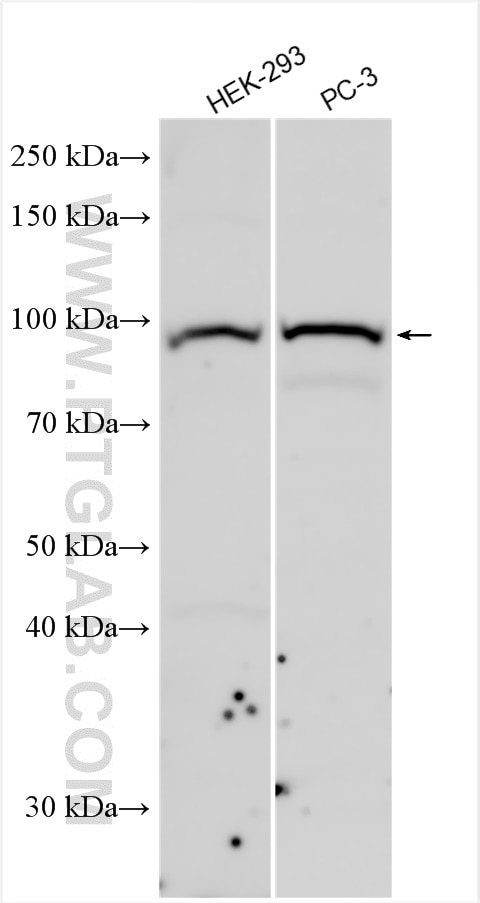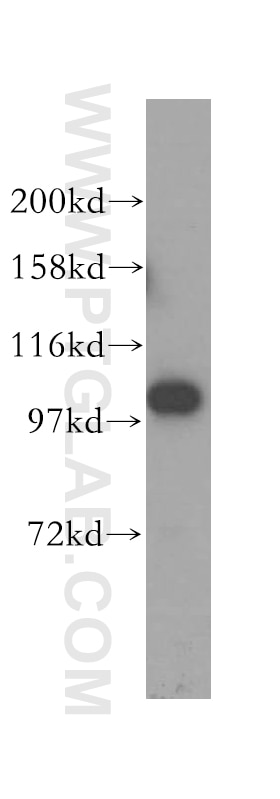- Phare
- Validé par KD/KO
Anticorps Polyclonal de lapin anti-MMS19
MMS19 Polyclonal Antibody for WB, IF/ICC, ELISA
Hôte / Isotype
Lapin / IgG
Réactivité testée
Humain, rat, souris
Applications
WB, IF/ICC, CoIP, ELISA
Conjugaison
Non conjugué
N° de cat : 16015-1-AP
Synonymes
Galerie de données de validation
Applications testées
| Résultats positifs en WB | cellules HEK-293, cellules PC-3, tissu cérébral humain |
| Résultats positifs en IF/ICC | cellules HeLa |
Dilution recommandée
| Application | Dilution |
|---|---|
| Western Blot (WB) | WB : 1:1000-1:6000 |
| Immunofluorescence (IF)/ICC | IF/ICC : 1:50-1:500 |
| It is recommended that this reagent should be titrated in each testing system to obtain optimal results. | |
| Sample-dependent, check data in validation data gallery | |
Applications publiées
| KD/KO | See 3 publications below |
| WB | See 17 publications below |
| CoIP | See 1 publications below |
Informations sur le produit
16015-1-AP cible MMS19 dans les applications de WB, IF/ICC, CoIP, ELISA et montre une réactivité avec des échantillons Humain, rat, souris
| Réactivité | Humain, rat, souris |
| Réactivité citée | Humain, souris |
| Hôte / Isotype | Lapin / IgG |
| Clonalité | Polyclonal |
| Type | Anticorps |
| Immunogène | MMS19 Protéine recombinante Ag8792 |
| Nom complet | MMS19 nucleotide excision repair homolog (S. cerevisiae) |
| Masse moléculaire calculée | 1030 aa, 113 kDa |
| Poids moléculaire observé | 103-113 kDa |
| Numéro d’acquisition GenBank | BC006575 |
| Symbole du gène | MMS19 |
| Identification du gène (NCBI) | 64210 |
| Conjugaison | Non conjugué |
| Forme | Liquide |
| Méthode de purification | Purification par affinité contre l'antigène |
| Tampon de stockage | PBS with 0.02% sodium azide and 50% glycerol |
| Conditions de stockage | Stocker à -20°C. Stable pendant un an après l'expédition. L'aliquotage n'est pas nécessaire pour le stockage à -20oC Les 20ul contiennent 0,1% de BSA. |
Informations générales
MMS19 plays a critical role in the biogenesis of multiple Fe-S proteins, which functions in genomic stability, RNA polymerase II function, and telomere length regulation. MMS19 has a alanine- and leucine-rich N terminus. It possible has a role in nucleotide excision repair(NER) and RNA polymerase II(POL II) transcription by interacting with ERCC2/XPB helicases, both subunits of NER-transcription factor TFIIH. Also MMS19 involves in the regulation of ER. It can function in chromosome segregation by acting as a part of the mitotic spindle-associated MMXD complex.
Protocole
| Product Specific Protocols | |
|---|---|
| WB protocol for MMS19 antibody 16015-1-AP | Download protocol |
| IF protocol for MMS19 antibody 16015-1-AP | Download protocol |
| Standard Protocols | |
|---|---|
| Click here to view our Standard Protocols |
Publications
| Species | Application | Title |
|---|---|---|
Mol Cell Cytosolic Iron-Sulfur Assembly Is Evolutionarily Tuned by a Cancer-Amplified Ubiquitin Ligase.
| ||
Cell Metab Human CIA2A-FAM96A and CIA2B-FAM96B Integrate Iron Homeostasis and Maturation of Different Subsets of Cytosolic-Nuclear Iron-Sulfur Proteins.
| ||
Nat Commun Structural basis for substrate recognition and chemical inhibition of oncogenic MAGE ubiquitin ligases. | ||
Cell Rep The CIA Targeting Complex Is Highly Regulated and Provides Two Distinct Binding Sites for Client Iron-Sulfur Proteins.
| ||
Mol Metab Cdkal1, a type 2 diabetes susceptibility gene, regulates mitochondrial function in adipose tissue. |




